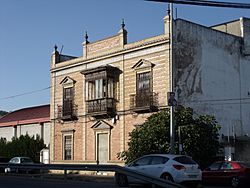Riotinto Mining Column facts for kids
Quick facts for kids Riotinto Mining Column |
|
|---|---|
| Columna minera de Riotinto | |
| Active | 18 July–19 July 1936 |
| Country | |
| Allegiance | Republicans |
| Type | Militia |
| Role | Demolition |
| Size | 250 |
| Garrison/HQ | Riotinto |
| Engagements | Spanish Civil War: Military uprising in Seville |
| Commanders | |
| Notable commanders |
Luis Cordero Bel, Juan Gutiérrez Prieto, Rafael Jurado Chacon |
The Riotinto Mining Column was a group of volunteer fighters. They formed on July 18, 1936, in the Riotinto mining areas of Huelva. Their goal was to take dynamite to Seville. The plan was for these miners to meet up with Republican civil guards and assault guards in La Palma del Condado. Together, they would enter Seville.
However, the commander of these guards changed sides. He joined the Nationalists. On the morning of July 19, he set a trap for the mining column. This ambush happened in La Pañoleta, just outside Seville. The guards attacked the miners, causing the dynamite to explode. Many miners were killed or captured. A military officer even said on the radio that the miners were coming to "blow up the Giralda and the cathedral".
What Happened
On July 18, 1936, a military uprising began in Seville. Fighting broke out between soldiers who rebelled and those who stayed loyal to the government. Sebastián Pozas, a government official, ordered that miners with explosives, along with guards, be sent to Seville. Their mission was to help stop the uprising.
Pozas sent a message to the governor of Huelva. He told him to gather all the miners. He wanted them to use explosives to fight the "terrorist gangs." He also mentioned a military group that was moving towards Cordoba and Seville.
The mining column was formed that same afternoon. It gathered in the Huelva towns of Riotinto, Nerva, and Calañas. Hundreds of people joined, mostly miners and union members. They were led by Luis Cordero Bel, Juan Gutiérrez Prieto, and Rafael Jurado Chacon. More volunteers from Valverde del Camino and San Juan del Puerto joined them along the way.
Their main weapon was a shipment of 250 kilograms of dynamite. They also had some rifles. For transport, they used 14 trucks taken from the Rio Tinto Company. Two of these trucks were homemade armored vehicles. They also had some cars and motorcycles.
The column took a route that avoided Valverde del Camino and La Palma del Condado. This was because they planned to meet 120 civil guards and assault guards from Huelva. But these guards had already reached La Palma. They then followed the Nationalists to Seville and joined them.
The Ambush
Early on July 19, the column continued towards Seville. In Castilleja del Campo, they took some shotguns. Then, in Castilleja de la Cuesta, they stopped to eat breakfast.
While they were in Castilleja de la Cuesta, a car passed by. It carried two members of the Falange, a political group. They went to Seville and joined the rebels. At 10:00 AM, the main commander of the Nationalist forces in Andalusia gave an order. He told the civil guards from Huelva to stop the mining column.
The guards drove their vehicles to Castilleja. They went through La Algaba to avoid roadblocks in Triana. In Camas, they stopped to remove any local resistance. They also made sure the town council was in Nationalist hands.
At noon on July 19, the column reached a place called "Cuesta del Caracol" in La Pañoleta. There, they fell into a trap set by the civil guards. After some confused shouting, the guards opened fire on the miners. One or more trucks loaded with dynamite exploded. Twenty-five miners died, and 71 were taken prisoner. Some trucks managed to turn around and escape. The rest of the column broke up and fled on foot.
The captured miners were put on trial by the Nationalists. Three of them died in prisons in Seville. Of the remaining 68, all but one young person were sentenced to death on August 29. They were then put to death. The Nationalist side used this event in their messages. They claimed the miners wanted to "blow up Seville" or specifically the Giralda.
In 2007, the town of Camas put up a monument to remember the Huelva mining column. In 2014, the remains of nine of the miners were found. They were buried in the old Camas cemetery.
See also
 In Spanish: Columna minera de Riotinto para niños
In Spanish: Columna minera de Riotinto para niños
- Spanish Coup of July 1936
- Asturian Miners Column
- Rio Tinto Company Limited
- Riotinto Railway
- Tourist Mining Train



